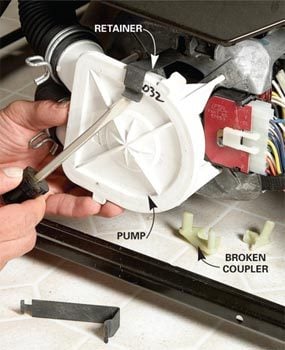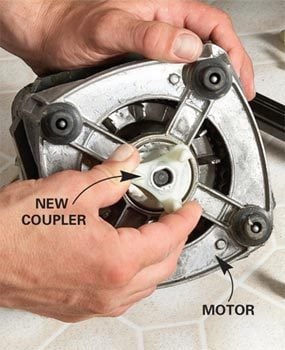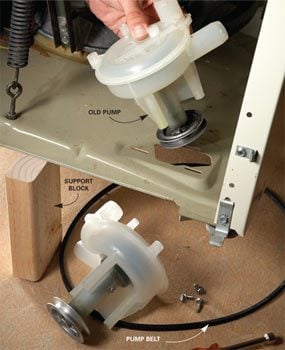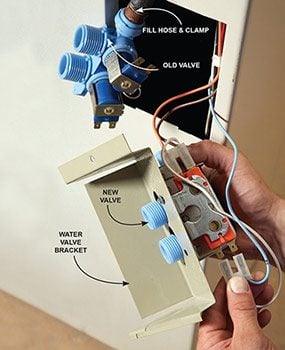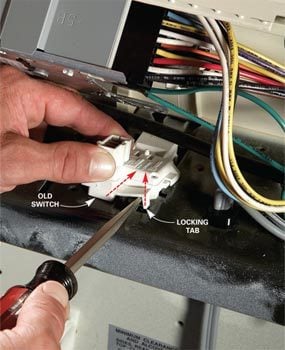DIY Washing Machine Repair
Updated: Mar. 08, 2024No experience necessary for these easy washing machine repair fixes
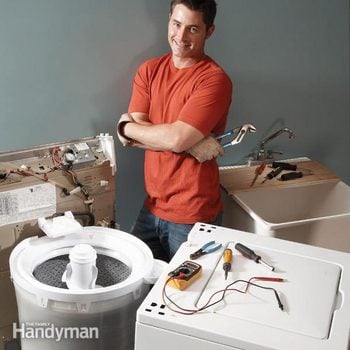
- Time
- Complexity
- Cost
- A full day
- Beginner
- $51–100
Overview: Time, tools and savings of washer repair
Instead of searching the internet for “washer repair near me”, we’ll show you how to fix it yourself. Washing machine repair may sound complicated, but these machines are pretty simple inside. With a few basic tools and the steps we show here, you can solve most problems yourself—and save the cost of a service call ($80 to $150). We won’t cover every fix, but the repairs we show will correct about 90 percent of washer troubles, like Maytag washer repair or Kenmore washer repair.
These common washer repairs are a snap for the average do-it-yourselfer. You’ll need a socket set or nut drivers, screwdrivers and a flashlight. Repairs can take as little as an hour, but set aside a full morning to diagnose the trouble, get parts and complete the repair. To find parts, check the yellow pages under “Appliance Parts” or search online for “appliance parts” for Maytag washer troubleshooting or a washer repairman.
Figures A and B on the following pages show two common washer styles. The outer cabinet shown in Figure A (Whirlpool and some other brands) lifts off completely, giving you access to all the parts. The washer shown in Figure B (Maytag and some other brands) has removable front and back panels.
Tip: Make sure your washer has power! Unplugged cords and tripped breakers are common causes of appliance “breakdowns.”
For more money-saving fixes, type “appliance repair” in the search box above.
Figure A: Whirlpool-Type Washer
To remove the outer cabinet from this type of washer, first pull off the side trim pieces and remove the retaining screws. Flip the console up and release the spring clips with a screwdriver. Tilt the cabinet forward and lift the cabinet off.
Note: Figure A showing Whirlpool washer repair is available in pdf format in Additional Information below.
Figure B: Maytag Washer Repair
To remove the front panel on this type of washer, yank the bottom of the panel outward (you may have to first remove screws). Pull the panel down and out.
Note: Figure B of a Maytag washer repair is available in pdf format in Additional Information below.
Caution
Unplug your washer before you begin any testing or repairs.
Fix 1: Grinding noise
If you own a Whirlpool direct-drive washer (the water hoses attach to the left side when viewed from the back), you’ve probably got a broken coupler—a common failure caused by overloading the machine. It’s an easy and inexpensive fix, about $22.
Fix 2: Draining problems
When clothing or jewelry gets stuck in the hose to the pump or in the pump itself, the machine won’t drain and you might hear squealing or grinding or smell burning rubber. First remove the hose that goes from the tub to the pump (drain the water into a bowl) and check for stuck socks (yes, that’s where they go). Then run a coat hanger through the tube and pull out the stuck objects. Next check the pump for broken blades by shaking it. Rotate the pump shaft to make sure it spins freely. Replace the pump if you find any damage ($55 for Maytag; $44 for Whirlpool). If you see any burned or melted sections on the belts, replace them ($35 a set). Maytag belts are specially designed, so don’t substitute an ordinary “V” belt.
Fix 3: Slow fill or no fill
If your washing machine fills slowly or won’t fill at all, try cleaning the inlet screens on the water valve. To see how, type “inlet screen” in the search box above. If that doesn’t help, replace the entire water valve assembly ($35).
Fix 4: Won’t agitate or spin
If the machine fills with water and then just sits there, suspect a broken lid switch. To test the switch, you’ll need a continuity tester (about $8) or a multimeter (about $15). If you don’t know how to use a multimeter, type “multimeter” in the search box above. Remove the wires connected to the switch and touch the tester’s probes to the switch’s connectors. As you open and close the lid, readings should alternate between continuity and no continuity. If not, replace the switch ($33).
To replace the switch on a Whirlpool-type washer (Figure A), just remove the two screws and screw in the new one. To get at the switch on a Maytag-type washer (Figure B), you’ll have to unscrew the access panel behind the console and replace the switch as shown here. Remember to raise the lid before you remove the old switch.
Tip: Never drop a washing machine’s lid! Slamming the lid eventually wrecks the lid switch.
Additional Information for Washing Machine Repair
Required Tools for this Washing Machine Repair Project
Have the necessary tools for this DIY washing machine repair project lined up before you start—you’ll save time and frustration.
- 4-in-1 screwdriver
- Flashlight
- Nut driver
- Pliers
- Socket/ratchet set
Required Materials for this Washing Machine Repair Project
Avoid last-minute shopping trips by having all your materials ready ahead of time. Here’s a list.
- New parts as needed
